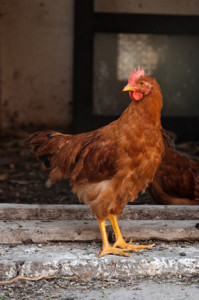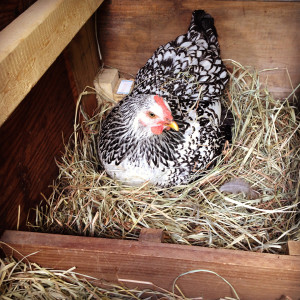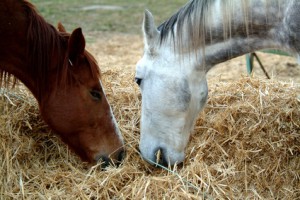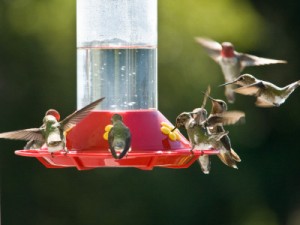 Molting is the process wherein hens lose feathers and grow new ones. It occurs naturally after 10 to 14 months of production, or it can be caused accidentally by temperature extremes, running out of feed or water, a decrease in light, or disease. Hens will not lay eggs during a molt. Molting gives birds a chance to rest. After seven to eight weeks, they will return to production for a second cycle, though they will not be as productive the second time around. However, they will often lay larger eggs than during their first cycle.
Molting is the process wherein hens lose feathers and grow new ones. It occurs naturally after 10 to 14 months of production, or it can be caused accidentally by temperature extremes, running out of feed or water, a decrease in light, or disease. Hens will not lay eggs during a molt. Molting gives birds a chance to rest. After seven to eight weeks, they will return to production for a second cycle, though they will not be as productive the second time around. However, they will often lay larger eggs than during their first cycle.
Archive for the ‘Uncategorized’ Category
Chickens and Molting
Monday, February 16th, 2015Chicken Chat: Why do hens stop laying?
Monday, February 16th, 2015Here are some reasons why your hens may not be producing eggs.
 LIGHT:
LIGHT:
Many things can cause hens to stop laying eggs, but the primary reason is decreasing day length. Hens need a minimum of 17 hours of daylight to sustain strong production. If you don’t provide your hens with supplemental light, they will naturally stop laying eggs when daylight drops below 12 hours per day. Hens may also stop laying if light abruptly decreases by a few hours. This is a hormonal response regulated by a tiny gland that responds to changes in light. One 40-watt bulb per 100 square feet of coop space is enough to keep birds laying. Use an automatic timer to keep light and dark hours constant; just a day or two of too little light can end a laying cycle.
NUTRITION:
Inadequate nutrition is another reason hens stop laying and, surprisingly, the missing nutrient is often water. Hens need a constant source
of fresh water, and they do not like it very cold, so it is important to check and refresh waterers often in the winter. Cool water in the summer will help the birds combat the effects of heat. Never underestimate the importance or power of clean water at the right temperature!
Inadequate protein and/or energy can cause a production decrease. A shortage of dietary calcium will result in weaker eggshells and, eventually, weak bones as the hen robs her skeleton of calcium in an attempt to manufacture shells. Feeding too much “extra” feed, such as scratch grains or table scraps, can dilute and unbalance the complete nutrition in the hen‘s pellets or crumbles, thereby affecting her production and health. Hot weather will inhibit a hen‘s appetite, causing her to eat less and resulting in a drop in egg production on even the best diets. Offer a high-quality feed and severely limit table scraps and alternative feeds to obtain maximal egg production.
DISEASE:
Diseases and parasites will reduce a hen‘s productivity as well as her comfort. Build a relationship with a veterinarian who can help you establish a good flock health program. Never introduce new adult birds into your flock — apparently healthy adult birds can be carriers of a number of deadly diseases. Keep all premises as dry as possible to limit growth of coccidia, an insidious and stubborn parasite that flourishes in dampness causing coccidiosis.
AGE:
Egg production decreases with increasing age. Good hens will productively complete two egg-laying cycles of 50 to 60 weeks each. After that, production will drop off greatly.
STRESS:
Any kind of stress — extreme temperatures, excessive handling or moving, fright caused by predators, or noisy children (they’re all the same to a hen!) — will negatively affect egg production. Keep your hens’ environment as serene and comfortable as possible to help maintain health and productivity.
SECRECY:
Sometimes what appears to be a reduction in egg production is really the result of free-range hens hiding their eggs. Be sure you have enough nesting sites for the number of hens you are keeping, especially if you are allowing some to be “broody.” Make sure the nesting area is warm, comfortable, dimly lit and well-bedded with clean litter. Give the hens lots of good reasons to lay their eggs where you want them.
Source: Purina Poultry
Horse Q&A: Amount and Type of Feed
Tuesday, July 10th, 2012 Am I feeding enough of the right type of feed?
Am I feeding enough of the right type of feed?
Since most people feed by the “scoop” rather than by weight, if is often easy to overestimate the amount of feed you are providing. Weighing out your feed will help. Additionally, be sure to consult the feeding directions on the back of the bag. Most feeds are formulated in such a way that a minimum feeding rate is required to provide for the nutrient and calorie requirements of a particular weight, lifestage and lifestyle. For example, you may be feeding your horse 5 year old 1000 lb. horse in light work one scoop of Strategy twice a day but he is losing weight. You decide to weigh out one scoop of Strategy and find that your scoop holds one pound of Strategy, therefore you have been feeding 2 lb./day total. Strategy is formulated to be fed at a minimum rate of 3-4 lb. /day to an adult 1000 lb. horse in light work in order to provide the basic nutrients and calories a horse of that description requires. So even though you thought you were providing an adequate amount of feed, it turns out that based on weight, you weren’t and you need to increase the volume fed.
Source: Purina Mills Equine Specialist
Keeping Your Horse Cool In the Summer
Saturday, March 24th, 2012Cool as a cucumber … but what if you are a horse! Summer heat and humidity can be a dangerous combination for active horses.“Heat and humidity affect the horse, and with intense exercising, the excess heat has difficulty dissipating,” notes Dr. Glennon Mays, clinical associate professor at the Texas A&M College of Veterinary Medicine & Biomedical Sciences.
“Heat is a normal by-product of working muscles and increases during periods of increased exercise,” explains Mays. “Normally a horse cools itself by sweating which causes heat loss and thus its body cools as sweat evaporates from the skin’s surface.”
When humidity is high, less moisture can evaporate from the skin surface. Therefore the surface blood vessels will enlarge to help rid the horse’s body of excess heat.
“Overheating, or hyperthermia in the horse is due to a disturbance in the heat regulating mechanism of the horse’s body,” says Mays. “In addition to summer heat and humidity, poor stable ventilation, prolonged exposure to sun, extreme exercise, transportation/trailering stress, as well as excess weight and poor conditioning may contribute to overheating.”
“If your horse does become overheated, move the horse to a shady area or to a cool, well-ventilated barn. Then spray with cool water and place ice packs on the horse’s head and large blood vessels on the neck and the inside of its legs,” states Mays. “Be careful to not spray the horse’s face or get water in its ears; just sponge these areas gently.”
Horses naturally tend to “cool out” while walking rather than standing still, notes Mays. Therefore, application of ice packs can be challenging.
Allow the horse to have several swallows of cool, clean, fresh water every few minutes. There is a possibility of colic if your horse drinks large quantities of water in a short period of time.
“To help your horse beat the heat, provide plenty of fresh, cool water,” notes Mays. “Keep water bucket or trough clean to promote drinking. Average size work horses can consume over 25 gallons of water per day when the temperature is above 70 degrees.”
Limit strenuous riding to late evening or early morning when the temperature is lower. Use less tack in the hot summer by minimizing saddle pads and leg boots. Also clip your horse’s coat and keep its mane and tail trimmed.
Heat stroke can happen to horses whether they are working hard, standing in stifling stables, or traveling in unventilated trailers, notes Mays. Call a veterinarian and take immediate action if your horse has elevated respiration or pulse (in an inactive horse), body temperature above 103 degrees, or irregular heart beat.
“Do the skin pinch test to check your horse’s hydration,” says Mays. Test for dehydration by pinching the skin along the horse’s neck. The skin should snap back quickly. If the pinched area collapses slowly the horse is dehydrated.
Hot weather does require that you give your horse special care. But, you and your horse can lessen summer’s hot days when you practice these cool tips to beat the heat.
This article is from:
PET TALK
Pet Talk is a service of the College of Veterinary Medicine & Biomedical Sciences, Texas A&M University. Stories can be viewed on the Web @ http://tamunews.tamu.edu.
Preparing Your Goats for the Winter Months Ahead
Sunday, March 18th, 2012Autumn is a good time to make sure everything in is in tiptop shape for the cold weather
that’s just around the corner. The preparations you make now can have a long-term impact on
the health and comfort of your goats, so here are a few fall tips:
• Even hardy animals like goats need a warm, dry place to get in out of the cold. Now is a
good time to make sure your shelter can protect your goats from cold winds, rain and snow
as the temperatures drop.
• Remember to replace wet, soiled bedding regularly. Goats need dry bedding in order to stay
warm.
• If you’re constructing a shelter, keep in mind that goats often prefer to sleep up on a
platform instead of at ground level.
• Fresh air is good for goats. At this time of year, you can probably allow your goats to come
and go as they please. But this winter, on days when the weather is especially frigid or wet,
you may want to keep your goats inside. If you do so, make sure your building has adequate
ventilation.
• Goats need access to fresh, clean water at all times. Autumn is the time to think about how
you will provide fresh water during freezing weather. A heater in the water tank will help
ensure water availability day and night.
• In cartoon shows, goats can exist on a diet of tin cans. But in the real world, nothing could
be further from the truth. Goats are actually very particular about what they eat. Goats are
primarily browsers, selectively eating a wide variety of shrubs, woody plants, weeds and
briars. But drought, land use and the time of year can result in inconsistencies in the quality
of forage. As a result, many goats are unable to get enough nutrients from browse alone to
meet their needs. To help your goats reach their full potential, it’s good to supplement with a
high quality feed like Purina® Goat Chow®.
• Even the best nutrition in the world can’t compensate for a parasite infestation (worms).
Parasites can keep your goats from maintaining a healthy weight or even impair your goats’
health. If you haven’t already done so, autumn is a good time for you and your veterinarian
to establish a regular de-worming program (most goat owners de-worm in spring and
autumn). A stool sample can help your veterinarian determine which parasites are causing
problems so that you can treat them more effectively.
• Goats become infected with parasites by grazing on pastures seeded with droppings from
infected goats. The first signs of infection are lethargy and rough hair coat. Animals that lose
weight, have a poor appetite and in many cases diarrhea, may already be in various stages of
anemia.
• Check your goat’s lips and tongue. If they are pale or white instead of a healthy pink, that
can be an indication of anemia caused by a parasite infestation. If a goat appears droopy,
lacks energy, loses its appetite or exhibits any outward sign of distress, consult your
veterinarian at once.
• Newly purchased goats should be treated for parasites and confined from the herd for at
least a week.
• Young kids and adults should be grazed on separate pastures.
• Rotate your de-worming agents to prevent drug resistance. Your veterinarian can advise.
• Another approach to parasite control is prevention. A pasture can become parasite-free if it
has been tilled or given prolonged rest at certain times of year or grazed by animals that are
unsatisfactory hosts for the parasites in question.
Fall is a great time of year to enjoy your goats. And by following the suggestions above,
you can head into the winter months with confidence.
Source: Purina Mills
Is Your Hay Supply Adequate Until Spring?
Saturday, March 10th, 2012Do you have enough hay stored to meet the needs of your cattle for the remainder of the winter? Even though you may have stored what you think will be enough hay to carry your herd through the winter, conditions often change so you might be concerned that you will run short before spring.
If you are worried about having enough hay on hand, Warren Gill, University of Tennessee Extension beef specialist, offers this formula to use to help estimate your available feed.
- Count the number of hay bales you have and, if possible, weigh a few to get an idea of their average weight. Multiply the number of bales by the average weight.
- During storage and feeding, you may lose 25 percent or more of large-package bales stored outside. Subtract this amount from the available feed.
- Calculate the number of animal units. Count a mature cow or bull as one unit, yearling cattle at a half unit and calves as a quarter unit.
- Determine the number of remaining total days you estimate you will need to use winter feed in your area.
- Figure each animal will eat 25 – 30 pounds of hay each day of average-to-good-quality hay with average wastage. Then, multiply your animal units times the number of days times the forage per day. Divide by the average weight of your bales to see how many bales you will need.
If you think your hay supplies will be inadequate and you need to obtain more, you can contact your university extension service or other sources for finding more hay or figuring suitable strategies for stretching your hay supply. State Agricultural Departments in major cattle producing areas also provide listings of where additional hay might be available for purchase.
Here are some reminders for storing the hay when you get it:
- Soil contact with hay is the most important source of spoilage of hay stored outside. Place bales on crushed rock, a concrete pad or wood pallets, if possible. If you can’t avoid storing hay bales on the ground, pick a well-drained area preferably with sandy soil.
- Storing bales near the top of a sloping area reduces the amount of water flowing around them. Bale rows should run up and down a sloping area to avoid trapping surface water.
- Store hay in a sunny location with a southern exposure. Never store under trees or other shady areas where drying can be slow.
- Bale rows should run north to south rather than east to west.
Quick Tips To Help Reach BCS Goals
Saturday, March 10th, 2012Body condition scores (BCS) are an excellent means of monitoring the effectiveness of your beef-cow-nutrition program. Here are 10
management tips to help ensure your cows are at a target BCS of 6.0 by calving:
- Late summer-Evaluate your cows while still on grass. If they score thin to borderline moderate during this time and forage availability is still sufficient, provide a balanced protein and energy supplement to improve forage intake and increase forage digestibility.
- Weaning season-Sort cows by body condition and age. Feed according to target body condition scores desired by calving.
- Late lactation (2 months prior to weaning)-Depending upon current forage availability, supplementation and/or a modified weaning strategy may be necessary. Wean thin cows.
- Weaning-Pay particular attention to young cows weaning their first calf and cows beyond their prime age. They are most likely to be thin at this time.
- 100 days before calving-This is the last opportunity to gain body condition and is a good time to separate thin cows from cows in good condition and increase feed to thin cows.
- Calving-Thin cows are an indication that a change in the feeding program is needed.
- Breeding season-If cows are thin, additional supplementation and/or implementation of an early weaning strategy may be necessary.
- Feedstuffs-Always ensure availability of quality feedstuffs containing ample nutrient levels to meet elevated nutrient requirements of cows during important production periods.
- BCS fluctuation-Be aware that cow body condition ebbs and flows over time in relation to productivity and climatic conditions. Try to accurately evaluate the status of your cows’ BCS in relation to future levels necessary for key production periods.
- Supplements-Use supplement programs which correct for nutritional deficiencies and also complement and improve utilization of the base forage.
Good Nutrition Vital for Efficient Reproduction
Good nutrition is critical for efficient reproduction in cow-calf enterprises. Most reproductive failures in beef cows, for example, can be attributed to improper nutrition resulting
in thin body condition. The cow’s priorities for nutrition are maintenance, lactation, growth and reproduction. The nutrition level pre- and post-calving affects the conception rate of subsequent breedingseasons. Cows that are thin prior to calving will have a delayed onset of estrus. Thin cows after calving will have reduced conception rates.
Obesity is a problem in heifers that become fat during the growing phase. Fat heifers normally have lower than average reproductive rates. Immature cows continue to grow until
approximately 4 years of age. These young cows should be maintained through the yearly cycle about one body condition score (BCS) higher than mature cows to achieve the same
reproductive performance.
Monitor the effectiveness of your nutrition program in the long-term by herd performance records. But, to deal with your present situation in the short term, pay close attention
to the BCS of your cows.
According to information from the Minnesota University Extension Service, research has shown that each 10 percent of body weight lost before calving can result in a delay of the first heat period by 19 additional days. Cows too thin at calving take longer to recover and to start cycling for re-breeding. These cows will have lower conception rates than cows in moderate to good condition at calving. It is important to bring thin cows into condition as soon as possible to improve the odds of success at the start of the breeding season.
Dividing the cow herd into two groups according to nutritional needs, and feeding them accordingly, can have a positive impact on re-breeding success.
Bull Nutrition
Nutrition also is important for the reproductive efficiency of breeding bulls. Management of bulls includes the following three phases:
- Before breeding season – Nutrition prior to the breeding season is important as bulls will tend to lose weight during the season.
- Yearling bulls – Should be growing adequately and maintaining satisfactory body condition without becoming excessively fat. This will require between 25 and 30 pounds of dry matter from a ration that is about 80 percent high quality forage and 20 percent concentrate. A 12 percent to 14 percent protein ration is needed. In many cases, a complete feed that will put bulls in good rigor without over conditioning them is preferred.
- 2 year old bulls – Are already at most of their mature size, so their ration is not quite as crucial. Approximately 30 to 35 pounds of a ration consisting of high quality forage and 5 pounds of grain should meet their needs.
- Mature bulls – The nutrition program should be based on physical condition of the bulls at the start of the conditioning period. If they have wintered well, a high quality forage plus 5 to 7 pounds of grain will build the necessary energy reserves.
Bulls should be evaluated and separated into two groups as they come out of pastures. Those in good condition that need no special care should be placed in one group. They
will usually do well on primarily roughage diet. Young bulls that are still growing, and thin mature bulls, should be placed together so their nutrient needs may be met with some
supplemental feed. All bulls should have access to high quality minerals.
Purina Mills, LLC has feed products to meet the precise nutrient needs of both brood cows and breeding bulls. Your Purina representative can help you determine cow and bull
nutrient needs and select the supplements to help meet the specific needs of your herd.
Purina Mills ®
http://cattlenutrition.net/stellent/groups/public/documents/web_content/ecmd015735.pdf
